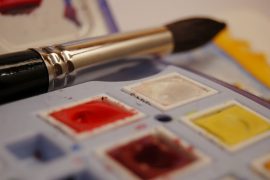Math shares its awareness month with another mission that is very near and dear to my heart: It is also Organ Donor Awareness Month. When I found that out earlier this week, I thought I’d indulge myself a bit and spend a post looking at the math of organ donation.
When I was in middle school, my father learned that he had a very strange autoimmune disorder. His immune system was attacking his liver. In fact, his liver looked like that of a raging alcoholic, which he wasn’t. After months and months of testing and treatments (some pretty ugly), his doctors were finally able to get things under control. But they told us one thing that stuck with me forever: “This isn’t a terminal disease, but it is chronic. As a result, he won’t live as long as he would have if he was healthy.”
To this day, we have absolutely no clue why my father’s immune system turned on him. When I was a toddler, he had surgery to remove part of his thyroid, because it was so overactive. As he aged, he developed other autoimmune disorders, including vitiligo, which caused his skin to lose pigment. But he kept on keeping on.
About seven years ago, his doctors discovered liver cancer. This was a specific kind of cancer, related to his liver disease. They could remove it, but the writing was on the wall: his liver was on its last legs.
So they put him on the liver transplant list. He stopped travelling more than a couple of hours from his hospital. He got poked and prodded. And he waited. And waited.
I’m not sure how many people were on the list at the time. Today, there are nearly 17,000 people waiting for liver donations. Each of these individuals are scored, based on the severity of their liver damage. In 2006, when my father was on the list, the median national waiting time was 321 days. I wasn’t able to find out how many people die before receiving a liver transplant, but it’s estimated that 6,500 people die each year while waiting for a heart, kidney or liver.
After eight months or so of waiting, my family and his doctors got worried. The tumors were coming back and multiplying. He needed a transplant soon. And so I made a decision that changed my life forever. I would donate my liver to him.
The liver is the only organ (besides the skin) that grows back. And a live-donor liver was a great option for someone like my dad. I flew through the medical testing with flying colors.
At about 5:00 a.m. on October 1, 2007, I was wheeled into an operating room at Virginia Commonwealth University Medical Center. They prepped me first, and then brought my father in for the transplant. The entire surgery took at least 8 hours, during which they took one full lobe of my liver and transplanted it into my father. Something like two hours of that time was devoted only to stitching up the large lambda-shaped incision that cut through my abdomen.
After two days of recovery, my father was off the ventilator, and I was walking down the hospital corridors on my own to visit him. Within another two weeks, an MRI showed that my liver had already grown back to about 95% of its original size. (I’m not kidding!) In that time, I had lost around 20 pounds, from not being able to eat for about a week and from the energy my body spent regrowing an organ.
I’m so sad to say that this story does not have a happy ending. I’m perfectly healthy. And my transplanted liver was doing great inside my dad. But no one knew that my father had pulmonary fibrosis. It must have been at the very, very early stages of his disease when he was tested and tested and tested prior to the transplant surgery. The doctors suspect that the progression of the disease was sped up considerably due to massive amounts of oxygen that were pumped into his lungs during surgery and while he was in intensive care.
Had he not had this complication, I have no doubt that he would be living today. He died on November 6, 2007; his liver was still going strong.
My point is not to share a very sad story. My point is to share with everyone some small mathematical facts about organ donation:
1. Each day, about 18 people die, while waiting for a kidney, liver or heart. (That’s 6,500* people per year divided by 365 days.)
2. Right now there are approximately 117,729 people waiting for a kidney, liver or heart. Each year, 4,000 more people join this list.
3. Becoming an organ donor doesn’t have to be as dramatic as my experience was. Most donated organs are from a deceased donor. It takes a split second for you to indicate on your driver’s license that you want to be an organ donor. Or you can sign up at OrganDonor.gov.
4. And happily, most people do not have my father’s experience. As of May 2009, 73.8% of those who had received a transplanted liver were still alive, five years after their surgery. Here are the percentages for others: 69.3% of kidney recipients, 74.9% of heart recipients and 54.4% of lung recipients.
5. It’s not just the big organs that matter. Organs and tissues from a single deceased donor can help up to 50 people. (Yes, 50!) On average 79 people each day receive a donor organ or tissue.
In fact, my father was so convinced of the value of organ donation that even after much of his body failed him, my father was able to donate his eyes, skin and tissue. It is an amazing thought that I and he were able to join together to do this.
So if you haven’t taken the time to indicate that you’d like to donate your organs after death, please do so now. I don’t regret for a moment my gift to my father. At the same time, had there been more deceased donors, it wouldn’t have been necessary.
Talk to your family about organ donation. Get some good information. And at the very least, make an intentional decision one way or the other.
*Earlier, I had a typo here. This number has been corrected.








Comments are closed.